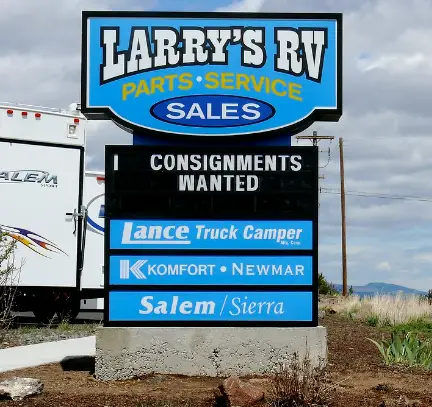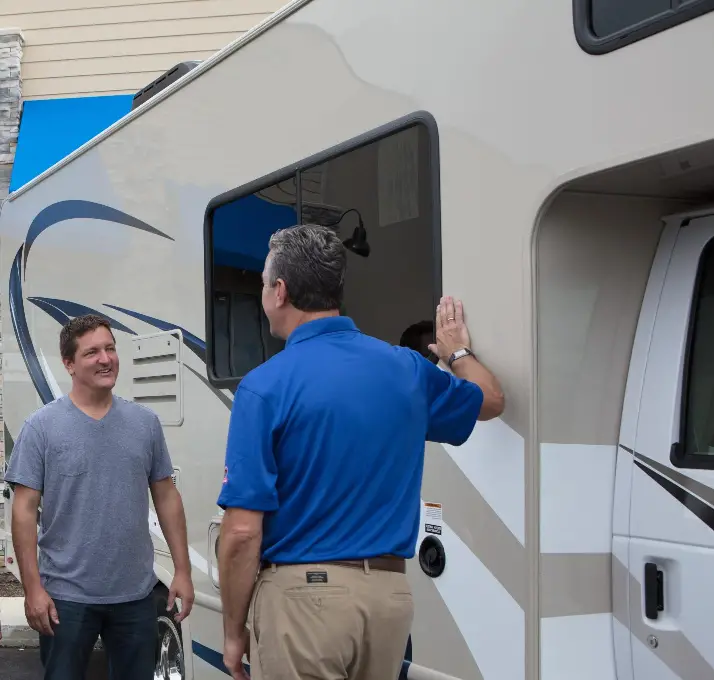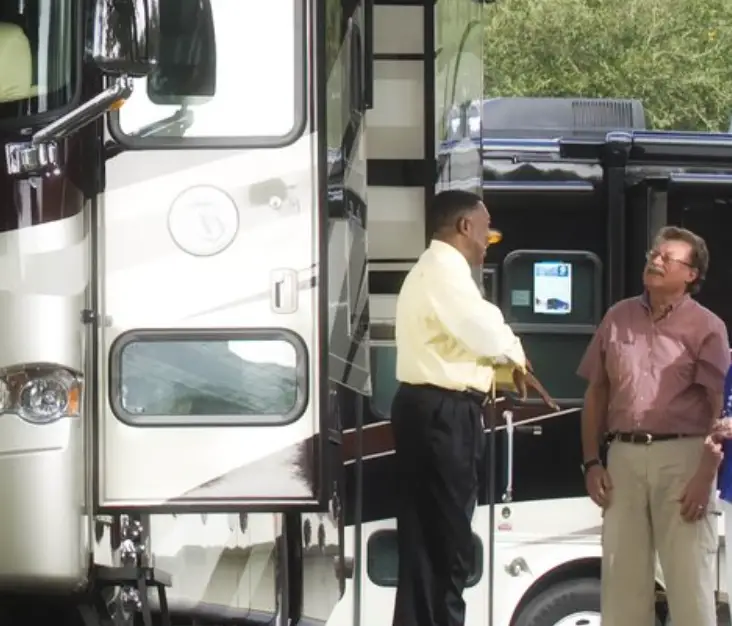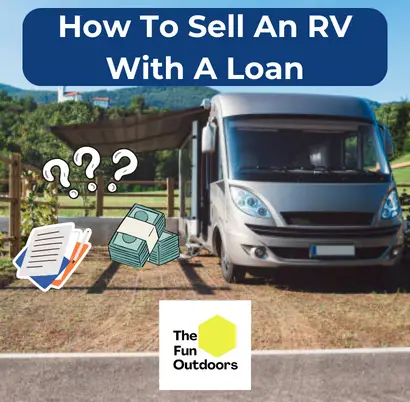Buying an RV is an exciting time, but what about selling an RV that you still owe money on? Figuring out how to sell an RV with a loan is important to ensure a smooth and successful transaction.
This article will provide you with the information you need to sell your RV with a loan, including how to prepare your RV for sale, determine its value, handle the loan and paperwork, negotiate with buyers, and explore alternative options for selling.
Key Takeaways
- Preparing your RV for sale and accurately determining its value are critical steps to a successful sale.
- Handling the loan and paperwork can be complicated, but there are options available to make the process easier.
- Exploring alternative options for selling, such as selling to a dealership, can be a good choice for those looking for a hassle-free transaction.
Understanding the Process

Selling an RV with a loan can be a daunting task, but it doesn’t have to be. Whether you’re looking to sell your RV to a private buyer or a dealership, there are several steps you can take to make the process smoother and more efficient.
First and foremost, it’s important to understand your existing RV loan.
This includes the amount of the loan, the interest rate, and any outstanding balance or lien on the vehicle.
Accurately determining how much you owe is crucial in determining the fair market value of your RV and ensuring that you have enough capital available to pay off the loan.
Once you have a clear understanding of your financials, you can begin to explore your selling options.
Selling to a dealership is often the easiest and quickest way to sell an RV with a loan.
Dealerships have the cash on hand to offer you a fair price for your rig and to handle your loan, paperwork, pay-offs, title work, and any other needs. This is especially true if you’re looking to sell quickly and don’t want to go through the hassle of advertising and promoting your RV to private buyers.
If you do decide to sell privately, it’s important to take steps to stand out among competitors. This includes creating a compelling ad that highlights the unique features and benefits of your RV, taking high-quality photos, and pricing it competitively.
You may also want to consider offering financing options to potential buyers, as this can make your RV more attractive to those who may not have the cash on hand to pay for it outright.
Ultimately, the key to selling an RV with a loan is to be knowledgeable, confident, and clear about your financials and your selling options.
By taking the time to understand your existing RV loan and exploring all of your selling options, you can ensure that you receive a fair offer and quick payment for your vehicle.
Preparing Your RV for Sale
When selling an RV with a loan, it’s important to prepare it for sale to make it stand out among competitors. Here are some tips to help you get started:
Clean and Repair Your RV
First and foremost, you want to make sure your RV is clean and in good condition. This includes both the interior and exterior of the vehicle.
Take some time to deep clean the RV, including the carpets, upholstery, and windows. Repair any damage or wear and tear, such as a broken window or a leaky faucet.
Address Any Rust or Corrosion
If your RV has any rust or corrosion, it’s important to address it before putting it up for sale.
Rust can be a major turnoff for potential buyers, and it can also indicate larger underlying issues with the vehicle. Consider having a professional inspect and repair any rust or corrosion.
Check the Mechanical Condition
The mechanical condition of your RV is also important to potential buyers. Make sure all systems and appliances are in working order, including the air conditioning, heating, plumbing, and electrical systems.
If there are any issues, consider having them repaired before putting the RV up for sale.
Take High-Quality Photographs
When selling an RV with a loan, it’s important to have high-quality photographs that showcase the vehicle’s features and condition.
Take photos of both the interior and exterior of the RV, including any unique or standout features. Make sure the photos are well-lit and in focus.
Make Your RV Stand Out
Finally, make your RV stand out among competitors. Consider adding some personal touches, such as new bedding or decor, to make the RV feel more welcoming and inviting. Highlight any unique features, such as a solar panel system or custom paint job.
By making your RV stand out, you’ll increase its chances of selling quickly and for a fair price.
Determining the RV’s Value

Before selling an RV with a loan, it is essential to determine its fair market value. Accurately evaluating the RV’s worth will help the seller set a reasonable price and ensure that they have enough capital to repay the original loan. Here are some methods to determine the RV’s value:
NADA RV and Kelley Blue Book RV Values
NADA, or the National Automobile Dealers’ Association, and Kelley Blue Book are two of the most popular sources for determining the value of an RV.
Both entities provide a range of prices and values for different types of RVs, including motorhomes, travel trailers, truck campers, and park models.
While KBB doesn’t valuate used RVs, NADA offers a similar service that can help sellers determine the RV’s base price.
Appraisal
Getting an appraisal from a professional RV dealer is another way to determine the RV’s value. An appraisal will give the seller an accurate estimate of the RV’s worth based on its condition, age, and features. Be careful though, as an appraisal may not reflect the current market conditions and trends.
Trade-in Value
If the seller is planning to trade-in their RV, they can use the trade-in value as a basis for determining the RV’s worth. The trade-in value is the amount that the dealer is willing to pay for the RV in exchange for a new one. RV trade-in values are usually lower than the fair market value, so sellers should keep that in mind when using this method.
RV Dealerships
RV dealerships can also help sellers determine the fair market value of their RV. By visiting different dealerships and getting quotes, sellers can get an idea of how much their RV is worth.
It is important to note that dealerships may offer lower prices to increase their profit margins.
Handling the Loan and Paperwork

Selling an RV with a loan can be a bit complicated, but it’s not impossible. It requires careful planning, proper documentation, and an understanding of the process. In this section, we will discuss the steps involved in handling the loan and paperwork when selling an RV with an existing loan.
Firstly, the seller needs to contact the lender and inform them of their intention to sell the RV.
The lender will then provide the seller with the payoff amount, which is the amount required to pay off the existing loan.
The seller needs to ensure that they have enough money to pay off the loan before selling the RV.
Next, the seller needs to gather all the necessary documentation, including the RV title, registration, and any other relevant paperwork.
They should also check if there is a lien on the RV, which means that the lender has a legal right to the RV until the loan is paid off.
If there is a lien, the seller needs to ensure that the lender releases it before selling the RV.
Once the seller has all the necessary documentation, they can start looking for potential buyers.
It’s important to disclose the existing loan to the buyer and provide them with all the relevant information, including the payoff amount and the lender’s contact information.
When a buyer is found, the seller can use an escrow account to handle the loan and paperwork.
An escrow account is a third-party account that holds the funds until the transaction is complete.
The buyer can deposit the funds into the escrow account, and the seller can use the funds to pay off the loan.
Once the loan is paid off, the lender will release the lien, and the seller can transfer the RV title to the buyer.
Negotiating with Buyers

Once a potential buyer has made an offer on the RV, it’s time to start negotiating. This can be a nerve-wracking process, but with the right approach, it can be a smooth and successful transaction.
First, it’s important to remember that the buyer is likely looking for a fair deal.
They want to feel like they’re getting a good value for their money, just as you want to get a fair price for your RV. Keeping this in mind can help set the tone for negotiations.
It’s also important to be clear about any outstanding loan payments and how they will be handled.
If the buyer is purchasing the RV with financing, it’s important to make sure that the loan is paid off before the title is transferred.
If the buyer is paying cash, the loan can be paid off at the time of the sale.
Being transparent about any outstanding payments can help build trust with the buyer and make negotiations smoother.
When negotiating, it’s important to be confident and knowledgeable about the RV’s value.
Researching similar RVs for sale in the area can help provide a baseline for what a fair offer might be.
If the buyer’s offer is too low, it’s okay to counter with a higher price. Be willing to compromise and find a price that works for both parties.
If negotiating with a private buyer, it’s important to take precautions to protect oneself from scams or fraud.
Meeting in a public place and accepting payment through a secure method, such as a cashier’s check or wire transfer, can help ensure a safe and successful transaction.
On the other hand, selling to a dealership can provide a quick payment and take care of any outstanding loan payments or paperwork.
The offer may be lower than what a private buyer might offer. Weighing the pros and cons of selling privately versus selling to a dealership can help determine the best option for the seller.
Overall, negotiating with buyers can be a successful process with the right approach.
Being transparent, confident, and knowledgeable can help build trust and lead to a fair and successful transaction.
Alternative Options for Selling an RV

If selling the RV privately or to a dealership is not an option, there are alternative methods to consider.
Each method has its own advantages and disadvantages, so it is important to weigh them carefully.
Trade-In Your RV
One option is to trade in the RV to a dealership when purchasing a new RV. This method can simplify the selling process and potentially save time, but it may not yield the best price for the RV.
Dealerships may offer a lower price for the RV in order to make a profit on the new RV sale.
Sell Your RV On Consignment
Another option is to consign the RV to a dealership or RV consignment company. This involves leaving the RV with the company to sell on the owner’s behalf.
The company will take a percentage of the sale price as commission.
This can be a good option for those who do not want to deal with the selling process themselves, but it may take longer to sell the RV and the commission fee can be high.
Rent Out Your RV
Renting out the RV can be an option for those who do not want to sell the RV but need to make payments on the loan.
Renting out the RV can generate income to cover the loan payments, but it is important to check with the lender to ensure that renting out the RV is allowed.
It is also important to consider the potential wear and tear on the RV and the cost of maintenance and repairs.
Trade Down Your RV Model
If the owner needs to sell the RV quickly, trading down to a smaller, less expensive RV can be an option.
This can reduce the loan amount and make it easier to sell the RV.
It is important to carefully consider the owner’s needs and the potential resale value of the smaller RV.
Sell Your RV to a Dealership
Selling the RV to a dealership can be a quick and easy option, but it may not yield the best price for the RV.
Dealerships may offer a lower price for the RV in order to make a profit on the resale. It is important to shop around and compare offers from different dealerships to get the best price for the RV.
Completing the Sale

Once the buyer has agreed to purchase the RV, it is time to complete the sale. The first step is to agree on the payment method.
If the buyer is paying with cash, it is important to count the money carefully and make sure it is the agreed-upon amount.
If the buyer is paying with a check, it is important to verify that the check is valid and not fraudulent.
If the buyer is paying with a check, the seller should wait until the check clears before transferring ownership of the RV.
This can take several days, so it is important to be patient.
If the buyer is paying with a wire transfer or other quick payment method, the seller should verify that the payment has been received before transferring ownership.
Once the payment has been received, the seller should sign over the title to the buyer.
It is important to make sure that the title is signed correctly and that any liens on the RV have been satisfied.
If the RV is being sold with a loan, the seller will need to contact the lender to arrange for the loan to be paid off.
Once the loan has been paid off, the lender will release the lien and the seller can transfer ownership to the buyer.
It is important to make sure that the sale is completed correctly to avoid any legal issues down the road.
The seller should keep a copy of the bill of sale and any other paperwork related to the sale, including any warranties that were included in the sale.
See Related: How to Get a Title for a Camper Without a Title
If the buyer discovers a problem with the RV after the sale, the seller should be prepared to address any issues that arise.
In conclusion, completing the sale of an RV with a loan can be a complex process, but with careful planning and attention to detail, it can be done successfully.
By following the steps outlined above, sellers can ensure that the sale is completed correctly and that both parties are satisfied with the transaction.
Check out our other helpful guides related to buying and selling RVs:


